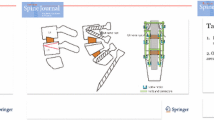Abstract
Introduction
Spinal shortening is indicated for osteoporotic vertebral collapse. However, this surgical procedure has not been indicated for more than two vertebral levels that are not adjacent. We experienced a rare case of paraparesis due to osteoporotic vertebral collapse of two vertebral bodies with a normal vertebra in between and treated successfully by the double-level posterior shortening procedure.
Materials and methods
A 79-year-old woman suffered from delayed paraparesis 2 years after L1 and Th11 vertebral body compression fracture. Plain X-ray photographs showed Th11 and L1 vertebral body collapse, Th7 compression fracture and a kyphosis angle of 30° from Th10 to L2. Plain magnetic resonance imaging showed spinal canal stenosis at Th11 and L1 vertebral body levels. She was treated by double-level posterior spinal shortening using pedicle screw and hook systems.
Results
After the procedure, the patient’s kyphosis angle decreased to 10° and her back pain, leg pain, and sensory deficits improved. She was able to walk by herself. Although new vertebral compression fractures occurred at L4 and L5 in the follow-up period, there has been no deterioration of the neurological symptoms 5 years after the operation.
Conclusion
Delayed paraparesis after double-level thoracolumbar vertebral collapse due to osteoporosis was treated successfully by double-level posterior spinal shortening using a pedicle screw and hook system.




Similar content being viewed by others
References
Arciero RA, Leung KY, Pierce JH (1989) Spontaneous unstable burst fracture of the thoracolumbar spine in osteoporosis. A report of two cases. Spine 14:114–117
Gertzbein SD, Harris MB (1992) Wedge osteotomy for the correction of post-traumatic kyphosis. A new technique and a report of three cases. Spine 17:374–379
Halvorson TL, Kelley LA, Thomas KA, Whitecloud TS 3rd, Cook SD (1994) Effects of bone mineral density on pedicle screw fixation. Spine 19:2415–2420
Hasegawa K, Takahashi HE, Uchiyama S, Hirano T, Hara T, Washio T, Sugiura T, Youkaichiya M, Ikeda M (1997) An experimental study of a combination method using a pedicle screw and laminar hook for the osteoporotic spine. Spine 22:958–962
Heining CF (1984) Eggshell procedure. In: Luque ER (ed) Segmental spinal instrumentation. Slack, Thorofare, pp 221–234
Kaneda K, Asano S, Hashimoto T, Satoh S, Fujiya M (1992) The treatment of osteoporotic-posttraumatic vertebral collapse using the Kaneda device and a bioactive ceramic vertebral prosthesis. Spine 17:S295–S303
Kempinsky WH, Morgan PP, Boniface WR (1958) Osteoporotic kyphosis with paraplegia. Neurology 8:181–186
Kim KT, Suk KS, Kim JM, Lee SH (2003) Delayed vertebral collapse with neurological deficits secondary to osteoporosis. Int Orthop 27:65–69
Kostuik JP, Matsusaki H (1989) Anterior stabilization, instrumentation, and decompression for post-traumatic kyphosis. Spine 14:379–386
Lee YL, Yip KM (1996) The osteoporotic spine. Clin Orthop Relat Res 323:91–97
Maruo S, Tatekawa F, Nakano K (1987) Paraplegia caused by vertebral compression fractures in senile osteoporosis. Z Orthop Ihre Grenzgeb 125:320–323
Murakami H, Yamazaki K, Attallah-Wasif ES, Tsai KJ, Shimamura T, Hutton WC (2006) A biomechanical study of 3 different types of sublaminar wire used for constructs in the thoracic spine. J Spinal Disord Tech 19:442–446
Saita K, Hoshino Y, Kikkawa I, Nakamura H (2000) Posterior spinal shortening for paraplegia after vertebral collapse caused by osteoporosis. Spine 25:2832–2835
Salomon C, Chopin D, Benoist M (1988) Spinal cord compression: an exceptional complication of spinal osteoporosis. Spine 13:222–224
Shikata J, Yamamuro T, Iida H, Shimizu K, Yoshikawa J (1990) Surgical treatment for paraplegia resulting from vertebral fractures in senile osteoporosis. Spine 15:485–489
Shimizu K, Ido K, Fujio K, Tanaka K, Nakamura T (1996) Total spondylectomy and spinal shortening for giant-cell tumour of spine. Lancet 348:342
Shimizu K, Hosoe H, Sakaguchi Y, Nishimoto H, Miyamoto K (2000) Spinal shortening for osteoporotic vertebral collapse. In: Proceedings of British orthopaedic association Japanese orthopaedic association combined congress, UK
Suk SI, Kim JH, Lee SM, Chung ER, Lee JH (2003) Anterior-posterior surgery versus posterior closing wedge osteotomy in posttraumatic kyphosis with neurologic compromised osteoporotic fracture. Spine 28:2170–2175
Toyone T, Tanaka T, Wada Y, Kamikawa K, Ito M, Kimura K, Yamashita T, Matsushita S, Shiboi R, Kato D, Kaneyama R (2006) Vertebral compression fractures following lumbar and thoracolumbar spinal instrumentation surgery: a study with a five-year minimum follow-up. International Society for the Study of the Lumbar Spine, Bergen
Author information
Authors and Affiliations
Corresponding author
Rights and permissions
About this article
Cite this article
Kikuike, K., Miyamoto, K., Hosoe, H. et al. Double-level posterior spinal shortening for paralytic osteoporotic vertebral collapse of two vertebral bodies with a normal vertebra in between: a case report. Arch Orthop Trauma Surg 129, 57–60 (2009). https://doi.org/10.1007/s00402-008-0606-x
Received:
Published:
Issue Date:
DOI: https://doi.org/10.1007/s00402-008-0606-x




